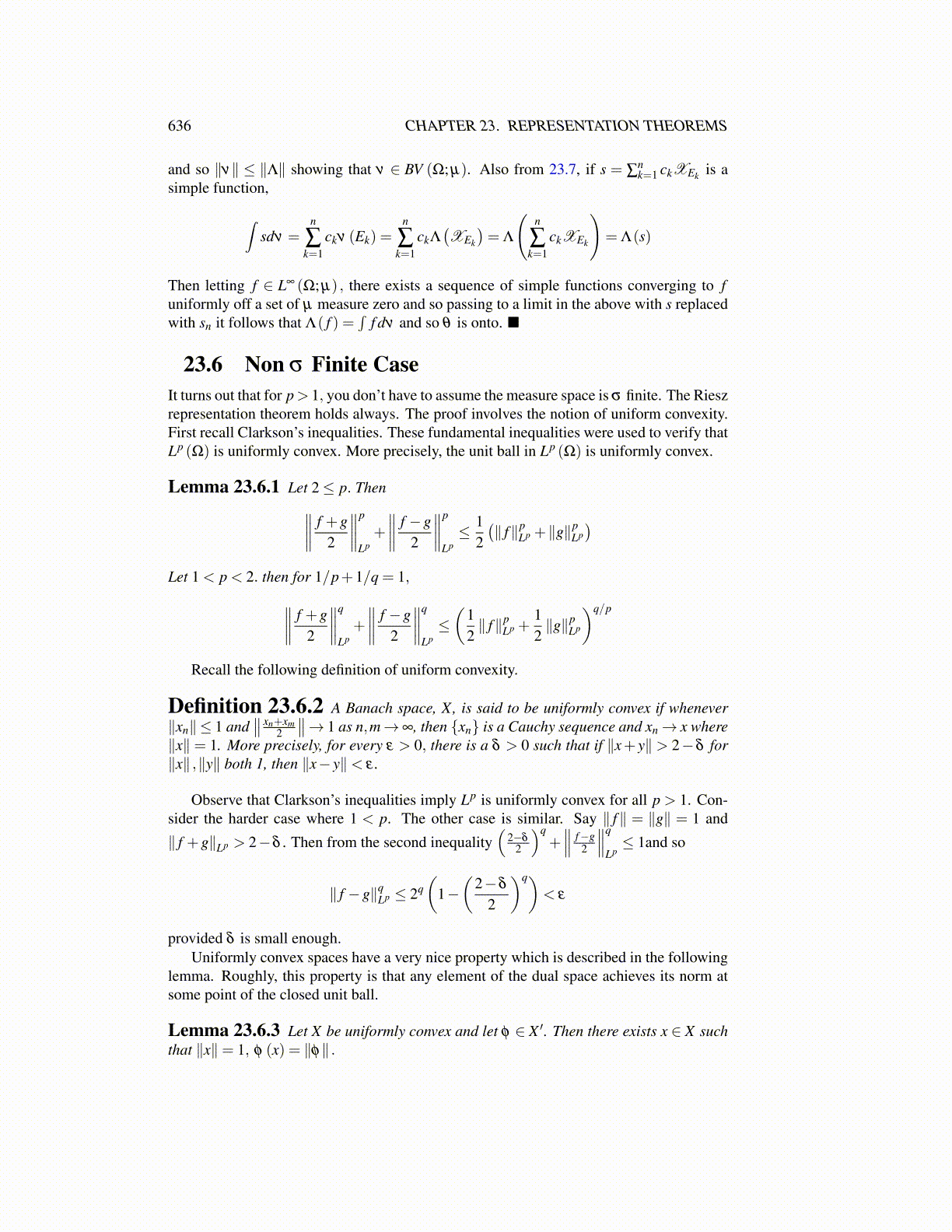
636 CHAPTER 23. REPRESENTATION THEOREMS
and so ∥ν∥ ≤ ∥Λ∥ showing that ν ∈ BV (Ω; µ). Also from 23.7, if s = ∑nk=1 ckXEk is a
simple function,
∫sdν =
n
∑k=1
ckν (Ek) =n
∑k=1
ckΛ(XEk
)= Λ
(n
∑k=1
ckXEk
)= Λ(s)
Then letting f ∈ L∞ (Ω; µ) , there exists a sequence of simple functions converging to funiformly off a set of µ measure zero and so passing to a limit in the above with s replacedwith sn it follows that Λ( f ) =
∫f dν and so θ is onto. ■
23.6 Non σ Finite CaseIt turns out that for p> 1, you don’t have to assume the measure space is σ finite. The Rieszrepresentation theorem holds always. The proof involves the notion of uniform convexity.First recall Clarkson’s inequalities. These fundamental inequalities were used to verify thatLp (Ω) is uniformly convex. More precisely, the unit ball in Lp (Ω) is uniformly convex.
Lemma 23.6.1 Let 2≤ p. Then∥∥∥∥ f +g2
∥∥∥∥p
Lp+
∥∥∥∥ f −g2
∥∥∥∥p
Lp≤ 1
2(∥ f∥p
Lp +∥g∥pLp)
Let 1 < p < 2. then for 1/p+1/q = 1,∥∥∥∥ f +g2
∥∥∥∥q
Lp+
∥∥∥∥ f −g2
∥∥∥∥q
Lp≤(
12∥ f∥p
Lp +12∥g∥p
Lp
)q/p
Recall the following definition of uniform convexity.
Definition 23.6.2 A Banach space, X, is said to be uniformly convex if whenever∥xn∥ ≤ 1 and
∥∥ xn+xm2
∥∥→ 1 as n,m→∞, then {xn} is a Cauchy sequence and xn→ x where∥x∥ = 1. More precisely, for every ε > 0, there is a δ > 0 such that if ∥x+ y∥ > 2−δ for∥x∥ ,∥y∥ both 1, then ∥x− y∥< ε .
Observe that Clarkson’s inequalities imply Lp is uniformly convex for all p > 1. Con-sider the harder case where 1 < p. The other case is similar. Say ∥ f∥ = ∥g∥ = 1 and
∥ f +g∥Lp > 2−δ . Then from the second inequality(
2−δ
2
)q+∥∥∥ f−g
2
∥∥∥q
Lp≤ 1and so
∥ f −g∥qLp ≤ 2q
(1−(
2−δ
2
)q)< ε
provided δ is small enough.Uniformly convex spaces have a very nice property which is described in the following
lemma. Roughly, this property is that any element of the dual space achieves its norm atsome point of the closed unit ball.
Lemma 23.6.3 Let X be uniformly convex and let φ ∈ X ′. Then there exists x ∈ X suchthat ∥x∥= 1, φ (x) = ∥φ∥ .